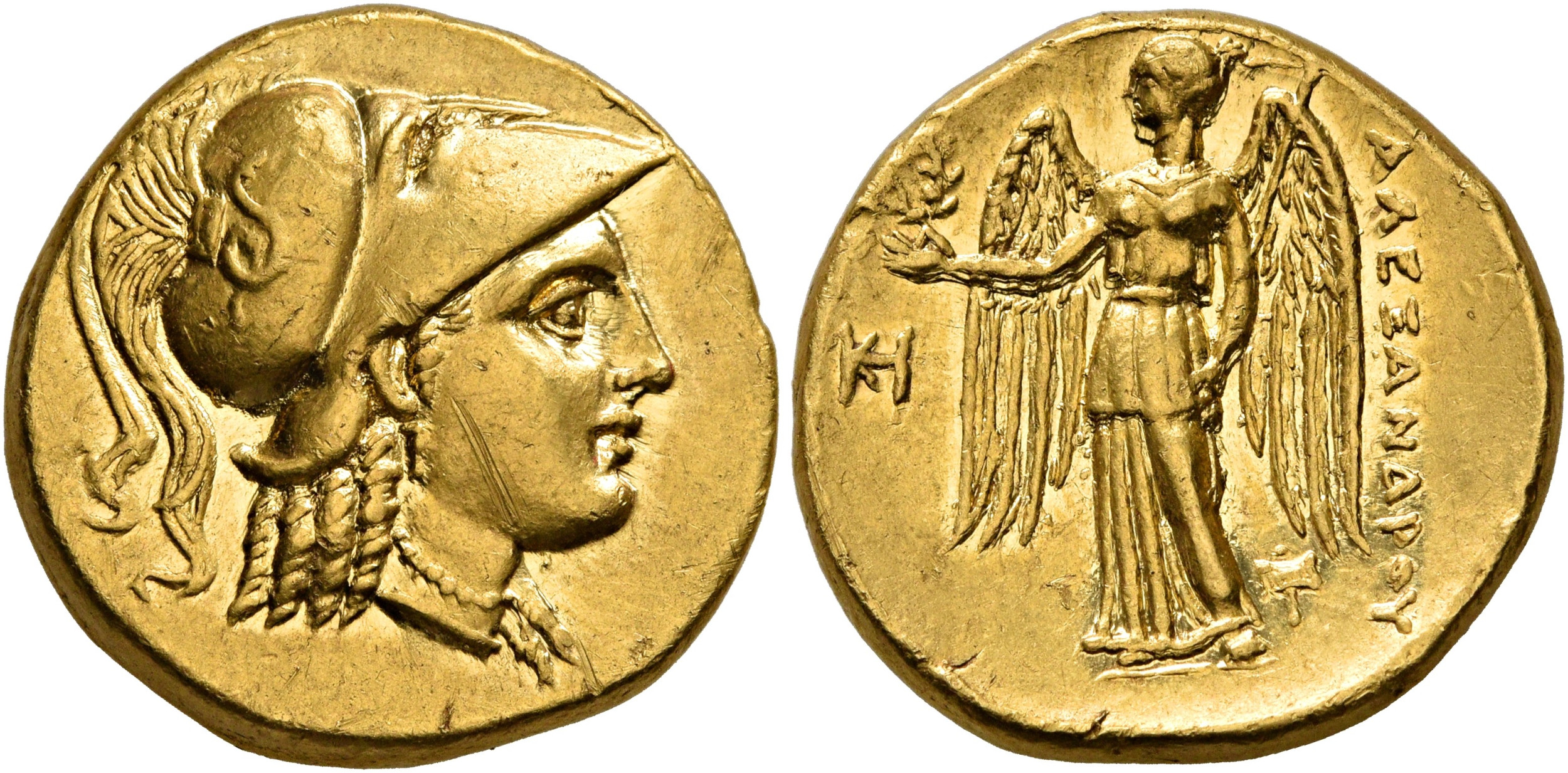Miletus (Alexander the Great), gold, staters (325-294 BCE)
From SILVER
325 BC - 294 BCE Gold 89,878 kg
Description
| ObverseInscription or printing placed on the obverse.: | Head of Athena to right, wearing Corinthian helmet decorated with a coiled serpent. |
| ReverseInscription or printing placed on the reverse.: | AΛΕΞΑΝΔΡΟΥ (Greek).Nike standing front, head to left, with her wings spread, holding laurel wreath in her right hand and stylis in her left, to left, monogram of KH, to lower right, labrys. |
Mint and issuing power
| MintIdentifies the place of manufacture or issue of a numismatic object.: | Miletus | Ancient regionAncient region.: | Ionia | Modern countryModern country: Turkey | AuthorityIdentifies the issuing power. The authority can be "pretended" when the name or the portrait of X is on the coin but he/she was not the issuing power. It can also be "uncertain" when there is no mention of X on the coin but he/she was the issuing power according to the historical sources: | Alexander III the Great (Argead king, 336-323 BC) |
Chronology
| FromIdentifies the initial date in a range assigned in a numismatic context. | 325 BC | toIdentifies the final date in a range assigned in a numismatic context.. | 294 BCE | PeriodTime period of the numismatic object.: Hellenistic 323-30 BC |
Physical description
| MetalThe physical material (usually metal) from which an object is made.: | Gold |
Median weightMedian of the weights of numismatic objects (in grams). in grams | 8.55 | DenominationTerm indicating the value of a numismatic object. Examples: tetradrachm, chalkous, denarius.: | stater |
StandardStandard.: | Attic |
Image

H223 Miletus stater.jpeg [1]
References
| Die study referencePublication of the study: | Thompson 19831Thompson 1983 | ||
| Coin series referenceReference to coin series study: | RQEMH2RQEMH, n° 223, Price 19913Price 1991, n° 2113-2115 | ||
| Coin series web referenceCoin series web references: | |||
Obverse dies distribution
| FrequencyFrequency of specimen in distribution. ᵖ | Number of obversesNumber of obverse dies. ᵖ (o) | % (o) | Number of coinsNumber of coins. (n) | % (n) | Die nameName(s) of the die(s). |
| 1 | 13 | 29.55 | 13 | 8.13 | 1, 5, 10, 15, 125, 157, 172, 205, 206, 224, 226, 243, 257 |
| 2 | 5 | 11.36 | 10 | 6.25 | 2, 4, 7, 11, 174 |
| 3 | 10 | 22.73 | 30 | 18.75 | 14, 18, 19, 126, 171, 177, 225, 227, 228, 258 |
| 4 | 5 | 11.36 | 20 | 12.5 | 12, 124, 169, 175, 244 |
| 6 | 1 | 2.27 | 6 | 3.75 | 3 |
| 7 | 4 | 9.09 | 28 | 17.5 | 21, 170, 173, 176 |
| 8 | 1 | 2.27 | 8 | 5 | 8 |
| 9 | 5 | 11.36 | 45 | 28.13 | 5, 6, 127, 128, 129 |
| Total | 44 of 44 | 99.99 | 160 of 160 | 100.01 |
Reverse dies distribution
no distribution is available
Quantification
| Number of obversesNumber of obverse dies. ᵖ (o) | 44 | Number of singletons (o1)The number of singleton coins. ᵖ | 13 |
| Number of reverse diesNumber of reverse dies. (r) | 62 | Number of coinsNumber of coins. (n) | 160 |
| Coins per obverse dieNumber of coins per obverse die. (n/o) | 3.64 | Coins per reverse dieNumber of coins per reverse die. (n/r) | 2.58 |
| Reverse per obverse ratioRatio of obverse dies divided by reverse dies. (r/o) | 1.41 | Percentage of singletons (o1)number of coins (n) divided by the number of singletons (o1) ᵖ | 29.55 % |
| Original number of dies (O) (Carter 1983 formula)The estimation of the number of coins according to Carter 1983 ᵖ | 52.56 | Coins struck if 20,000 as average productivity per dieCoins made if the average productivity for obverses (according to Carter) is 20,000. ᵖ | 1,051,200 |
| Original number of dies (O) (Esty 2011 formula)The estimation of the number of coins according to the singleton formula in Esty 2011 ᵖ (O) | 60.69 | Survival rate if 20,000 as average productivity per dieSurvival rate if average productivity is 20,000. ᵖ | 0.00015 |
| Coverage (o = % of O) (Esty 1984 formula)Esty 1984 - coverage (% of O) ᵖ (o = % of O) | 91.88% | Die productivity if survival rate 1/2,000Average productivity if survival rate is 1/2,000. ᵖ | 6,088.28 |
| Weight of silver (in kg) if 20,000 coins per die (O = Carter formula)Carter 1983 * Median weight * 20000 (*10 if gold or electrum) ᵖ | 89,878 kg <br /> 89,878 kg | Die productivity if survival rate 1/5,000Average productivity if survival rate is 1/5,000. ᵖ | 15,220.7 |
Remarks
References
- ^ Thompson, Margaret (1983), Alexander's Drachm Mints. I : Sardes and Miletus, NS 16, New York.
- ^ Callataÿ, François de (1997), Recueil quantitatif des émissions monétaires hellénistiques, Numismatique Romaine, Wetteren, X + 341 p.
- ^ Price, Martin Jessop (1991), The Coinage in the Name of Alexander the Great and Philip Arrhidaeus: a British Museum Catalogue, 2 vol., Zürich-London, 637 p., 637 p., clix pl.